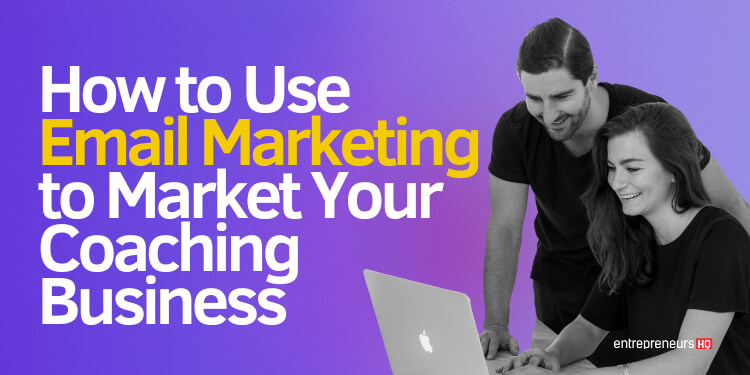
Looking for a reliable marketing channel that you probably use every day as a consumer to attract new coaching clients?
That’s email marketing.
Personally, I’ve built our email list to over 100,000 subscribers in the first 18 months of our business, and we get hundreds of new subscribers every week.
In fact, just last week (at the time of writing, March 2024), we sent an email that had a 16% click-through rate. This was down to our targeted list and a relevant offer for our clients.
In this post, I’m sharing the definitive guide to email marketing for coaches with actionable tactics and examples.
Table of Contents
Why is email marketing important for coaches?
Email marketing offers a unique opportunity for coaches to engage with their ideal clients. Regular, informative, and personal emails give your audience a chance to build trust in you, you nurture those leads, build a relationship, warming them up so that when you make an offer, they are ready to become your client
Sharing a little of your knowledge within your specific niche is a useful way to build authority, too. Clients will be more willing to invest their time and money into someone who really knows what they’re talking about, and email marketing is a very good way to achieve this.
The Benefits of Email Marketing for Coaches
There are tons of benefits to email marketing, specifically for coaches trying to build a rapport with potential new clients. These include:
- Showing your personality: This is a key draw for clients who will be working one-to-one with you.
- Build trust: By giving your readers useful information, they will start to see you as an authority figure.
- Marketing opportunities: Of course, you can advertise anything through your email newsletter, from upcoming events to books or PDFs to coaching services.
Take this example from one of my clients, Carl Cincinnato. Carl is the founder of the Migraine World Summit, and after working with me, he has over 100,000 email subscribers. That is a huge pool of potential new clients to work with.
How to Choose the Right Email Marketing Platform
So, you’ve decided to launch an email newsletter. The question is, which platform will you go with? I’ve had experience with a few over the years, and I’ve found that different platforms work better for certain things.
Factors to Consider When Choosing an Email Marketing Platform
Here are a few things you should think about before you start your email marketing efforts:
- Ease of Use: You don’t need to be super tech-savvy to make an email newsletter work. If you want something easy, look for a platform that works like a CMS or a word processor.
- Type of Content: What kind of content do you want to send out? Do you want to be able to send videos, coupons, audio clips, images?
- Contact Management: Look for features like segmentation and tagging, which allow you to target specific emails to certain groups of people.
- Analytics: Detailed analytics allow you to get a true picture of how your emails are performing.
- Pricing: Pricing varies between platforms, so you’ll need to find something that works for your budget.
Top Email Marketing Software for Coaches
Here are some of the most popular email marketing platforms used by coaches, including key features and pricing.
Keap
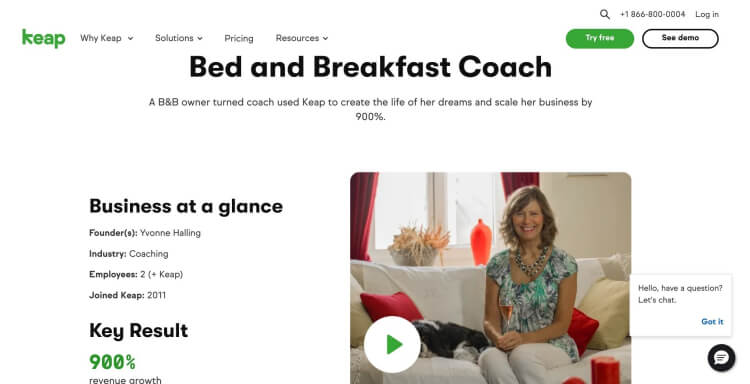
Keap is the platform I’ve been using since 2015 because it has some advanced features for coaches, including:
- Appointment scheduling to book consultations
- Referral programs to track affiliates
- CRM & workflow automation for email campaigns
- Quotes, invoices, and payment processing
The pricing starts at $159/mo for Pro, $229/mo for Max, and $229/mo for Ultimate.
Drip
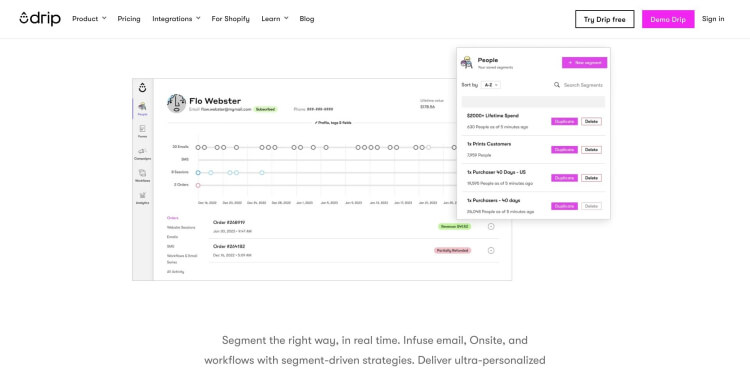
Drip is the platform I use for my podcast matching service and its CRM features are good for building a bigger audience. Features include:
- Smart segmentation to target specific clients with emails
- Pipeline builder to encourage new clients to sign up for a webinar
- Good CRM features to keep your clients organized
Pricing starts from $39 per month all the way up to almost $2k per month and beyond, depending on your needs.
ConvertKit
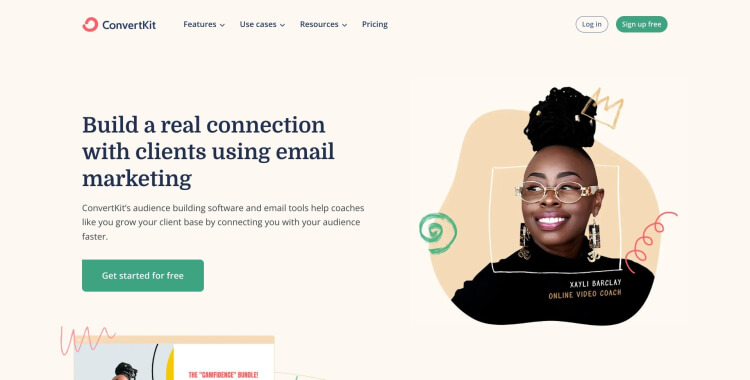
ConvertKit is an all-in-one marketing platform, and it has some features that work really well for coaches, including:
- Collaboration tools to work with other creators
- Personalized content for clients using segmentation
- The ability to give away freebies, like PDFs or exclusive content
Pricing starts from a free plan if you have a few subscribers, up to $50/mo which gives you access to pretty much everything.
Beehiiv
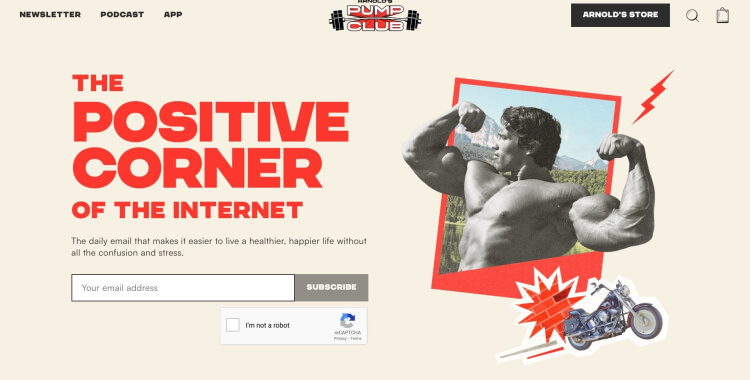
Beehiiv is a creative platform. It includes:
- Email designer for newsletters
- Landing page builder to generate leads
- Segmentation and CRM features
- The ability to create free content for your followers
You can start for free if you don’t have any followers yet or pay $49 per month for the Grow tier or $99 per month for the Scale tier.
Mailerlite
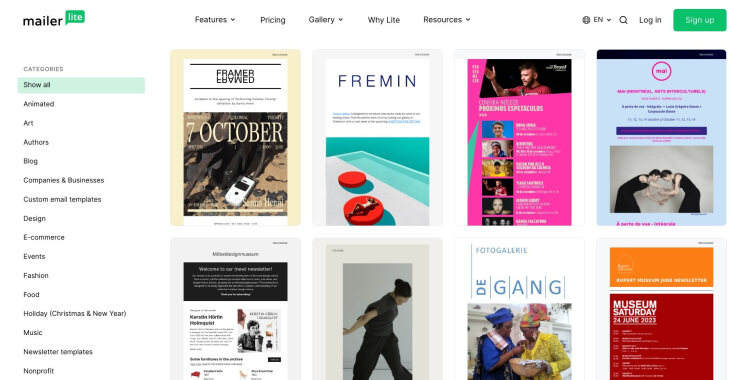
Mailerlite is designed to be really simple to use.
Features include:
- Automation builder for your email campaigns
- Segmentation and tagging of leads
- Coupons and discounts along with detailed analytics
Pricing starts from the free plan, up to $18 per month. If you have a particularly large following (over 100k followers), you need to contact them for a price quote.
Flodesk
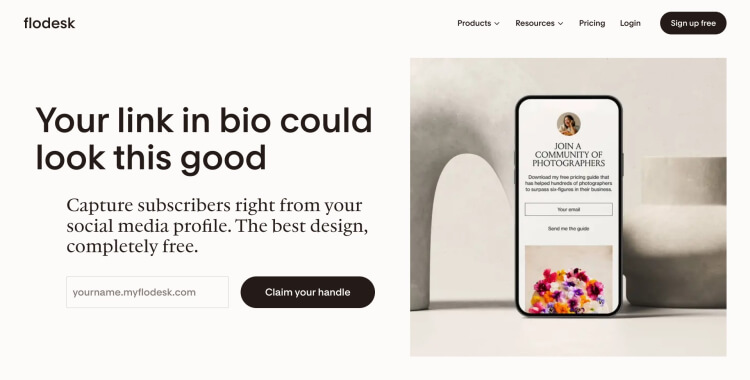
Flodesk is an intuitive platform. Features include:
- Stylish, simple email templates
- Automations for email campaigns
- Ability to capture subscribers from social media platforms
- Lead magnet creation and delivery
Pricing starts from $35/mo for their email marketing services.
Moosend

Moosend is a lesser-known platform aimed primarily at eCommerce businesses. However it’s also a solid platform for coaches. Features include:
- Automations for capturing new clients
- Detailed analytics with a simple interface
- CRM features like tagging and segmentation
Pricing starts from $9/mo up to $315/mo or more if you have over 50k subscribers.
Campaign Refinery

Campaign Refinery is a simple, stripped-back platform. It has some good features, including:
- Campaign library, with a roster of ideas to send to your audience
- Tagging system to organize clients
- Smart Goal Triggers to ensure your emails go to the right people
Pricing starts from $99/mo up to $1k/mo for unlimited subscribers.
ActiveCampaign
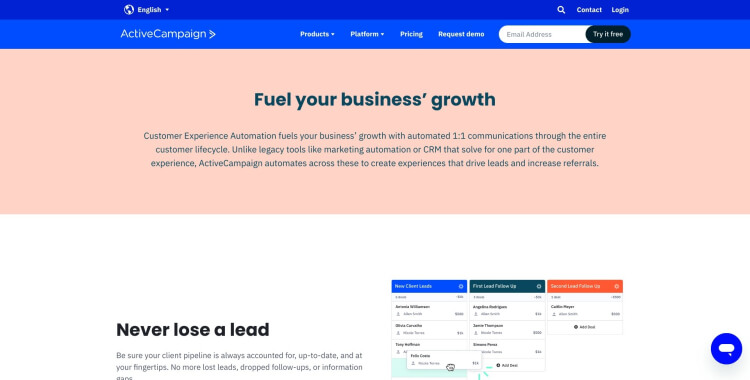
ActiveCampaign is a long-standing platform with some good features for coaches, including:
- Dynamic content creator to make simple, stylish emails
- Ability to create free content for subscribers
- Segmentation and tagging
- Good analytics to understand performance
Pricing starts from $49/mo to $259/mo, depending on the tools you’re looking for.
MailChimp
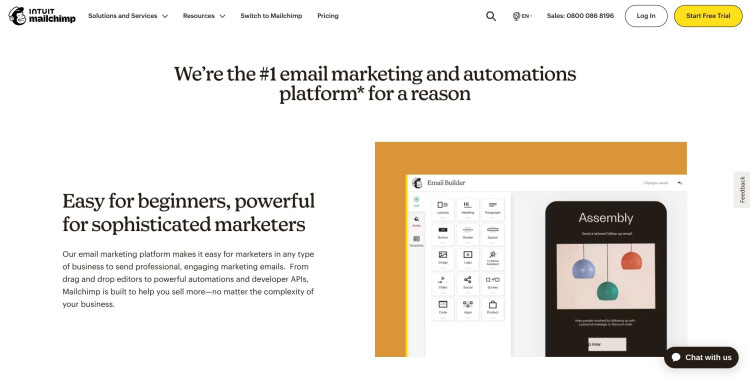
MailChimp is a great place to start from scratch, just follow my guide on how to use MailChimp for simple steps. Features include:
- Easy-to-use email builder
- Segmentation and tagging
- Good analytics
- Client management features to easily manage communications to different groups of people
- Free training for those new to email newsletters
Pricing starts from a free plan for basic features and up to $350/mo for premium features.
How to Build Your Email Marketing Strategy for Your Coaching Business
In my experience, you can’t just wing it, you need a decent email marketing strategy to build your coaching business and gain new clients.
Setting Goals and Objectives
What do you actually want to do with your list? Most of us want to build a decent following of people within our niche so that they will eventually sign up for one-to-one or group coaching services.
But you might have other goals. For example, to get a certain number of people to sign up to a workshop or a webinar. You might want to promote your ebooks, promote events, or build relationships.
Whatever the goal is, make sure you understand what it is, so you can plan around it.
Understanding Your Audience
Every year at EHQ, we do an annual survey to better understand our audience. This, to us, is crucial research that informs the content we create.
Customer research is really important. You need to build your ICP (or ideal customer profile) to understand the kind of people you’re looking to attract:
- Who are they? What age are they, where do they live, and what do they do?
- What are their goals? What are the outcomes they are looking for in their lives or in their careers?
- What are their specific pain points? What are their specific obstacles, and what’s holding them back?
Creating targeted content is the best way to build relationships with your audience and encourage them to sign up for your services.
How Often Should You Email Your List?
There are mixed opinions on this. In my view, it depends on the kind of content you’re offering. But at EHQ, we send out emails every day.
I’d say sending out emails at least 2-3 times a week will prevent your audience from forgetting about you, and will give them more opportunities to open and read your emails.
But use your common sense here. Your audience may be the kind of people who prefer weekly emails as opposed to daily. It may take a little experimentation to figure out what works best for you.
How to Craft Compelling Emails
You’ve figured out what your audience wants. Now you need to start creating compelling emails that appeal specifically to them.
There are some best practices to follow:
- Sending at the right time of day: Depending on where your clients are based, 9-11am is usually the best time.
- Don’t send spam: Don’t just send anything to fill your quota; send them something useful or relevant.
- Personalize the email greeting: This should be easy to do using your chosen platform, and it will make your audience feel comfortable with you.
- Don’t be afraid to make your emails personal: Include something about yourself and your story in your emails, so people grow to know, like, and trust you.
- Include a clear CTA in every email: This sounds obvious, but just triple-check that the CTA is in there and easy to see.
Writing Effective Subject Lines
Subject lines are key. You should spend a good amount of time perfecting these, they can make the difference between someone clicking ‘open’ or ignoring your email altogether.
I like to keep my email subject lines clear and concise, with an obvious ‘hook.’ The hook can look different depending on what your email is about. For example, if you’re starting a series of emails telling a personal story about a testing time in your life, you might lead with that in the headline.
Types of Email Content for Coaches
Let’s check out the type of content you can email to your clients.
Newsletters
I always like newsletters that give specific news and updates within a certain industry. For example, tech-related newsletters such as Wired and TechCrunch tend to perform well.
I’ll give you another example: The Download, MIT’s tech newsletter, is a simple, well-designed newsletter giving subscribers industry updates by experts. They know their target audience well.
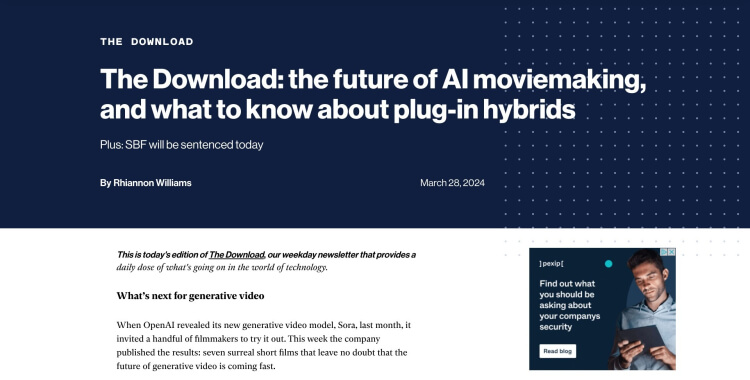
So think about the kind of curated news and updates you can offer your readers.
Educational Guides & Video
Educational videos can work well. For one, they allow you to build authority, and they also offer useful information for potential clients.
For example, I might take snippets from previous workshops, create small videos, and include them in a list of tips on how to create a virtual summit.
How-To Content
You are missing a transition sentence here about what how-to content actually is.
Here is an example from one of my clients. Sara Artemisia grew her email list by 5,000 people after working with me.

This information is going to be really useful for people looking to explore herbalism themselves, and receiving small tips on a weekly basis is a great way to give your audience some valuable content while always including a CTA back to your services.
Personal Stories
One of my clients, Jennifer Regular, is an author and spiritual coach. I like what she has to say to new subscribers.
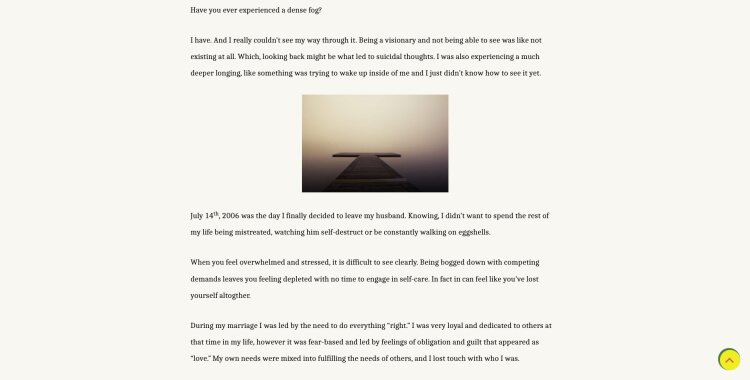
Jennifer is looking for clients who are on a spiritual journey, so sharing her own story is important to build trust.
Even if your services are less personal, sharing your own story is useful so that people can get to know you. For example, you could share how you got started out in your industry or be honest about hurdles and setbacks you’ve had along the way.
Promotional Offers
You can also drop some promo emails from time to time. This is great if you have a particular product you want people to buy or sign up for.
You might, for example, offer a percentage discount on a virtual workshop. Having sold over 1,000 workshops and launched dozens of them myself, I know how important these are for creating more income. All of my workshops are now evergreen, so new people can buy and watch them.
This means I can send out an email at any time offering my workshops at a discount. This gives your clients value and also allows them to get to know you more, creating that trust they need to sign up for one-to-one coaching.
Taking the example of Philip Duncan, a client of mine – he brought in $6.5k in revenue after running a workshop and then secured another $10k the next week from clients he obtained from the workshop itself. Offering a discount on a workshop for your email subscribers could be just the thing you need to drive new clients your way.
Case Studies & Testimonials
This is also a great way to advertise your services.
At EHQ, we use testimonials all the time to promote our coaching services to clients. Ask your former clients for a few words, chances are, they’ll be more than happy to help out.
For example, one of my clients, radio host Janine Bolon, left me this testimonial to use:
“All four of our podcasts were syndicated in October of 2021. We are now broadcasting one program across 112 different internet platforms and being broadcast from one radio station along with offering our broadcasts on a radio exchange free of charge (at least 87 stations have access to our programming)”.
This is excellent feedback because it’s so specific. If my niche was to offer specific coaching for podcast or radio hosts, this would be the kind of testimonial that builds trust and authority with potential new clients.
Tips for Designing Emails
There are a few things to keep in mind when it comes to designing emails:
- Think about how it will look on mobile vs. desktop: Many times, I’ve designed an email that looks perfect on a desktop, only to find that a logo has been squashed down or the font isn’t as readable on mobile. So make sure you check that out before you hit send.
- Think about white space: You need empty areas around your text, as well as in between paragraphs, to create contrast and a little balance, making it easier to read.
- Send test emails to colleagues or loved ones: If you have people around you wanting to help out, send a test email to them first and ask for feedback. Is the email readable? Does it look good on their device? Is it easy to click the CTA?
Tips for Email Personalization
Personalization is key to helping your readers feel that you care about them. You can personalize your emails in a few ways:
- Use dynamic content: For example, make sure that your emails start with each person’s name rather than a generic ‘Hello, everyone.’
- Use segmentation: This is the technical term for splitting your audience into sections, which will determine which emails they get.
- Make sure you offer subscription preferences: When signing up, you should offer a choice. Which emails will they get? How often will they hear from you? Offering this kind of personalization will ensure that your audience doesn’t feel overwhelmed with content from you.
- Use personalization snippets: You can even personalize sections of the email based on demographics or personal interests.
- Use personalization tokens: Like snippets, these are words that are replaced using personalization, like using your audience’s first names.
Growing Your Email List
One of the most common problems I encounter with my clients is how to grow their email lists. After an initial burst, it’s easy to become stagnant and encounter slow growth.
Here are some list-building strategies.
Creating Lead Magnets
This is a classic strategy and it works really well for my clients. Going back to my client Sara Artemisia, who I mentioned earlier: she has created a free hour-long workshop on plants in exchange for signing up for her emails.
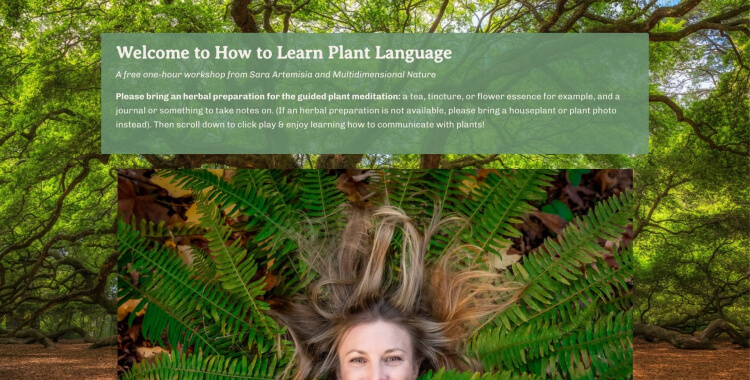
Think about what you can offer your clients. A specific tutorial, perhaps, or a workshop relating to a certain subject within your coaching niche. Then create a lead magnet based on that.
These don’t have to be videos, they can be podcasts, PDFs, ebooks, or access to a website. It can be anything you want it to be, really. It just needs to add value for your readers.
Opt-In Forms and Landing Pages
Most email marketing platforms allow you to create landing pages. Landing pages are a great way to encourage new subscribers to trust your knowledge.
As an example of a good landing page, we could look at one of my clients, Michael Morgan. We worked with him, and he generated $40,000 in the first 30 days of using our system.
Michael is an Alzheimer’s and longevity coach, and his landing page looks like this:
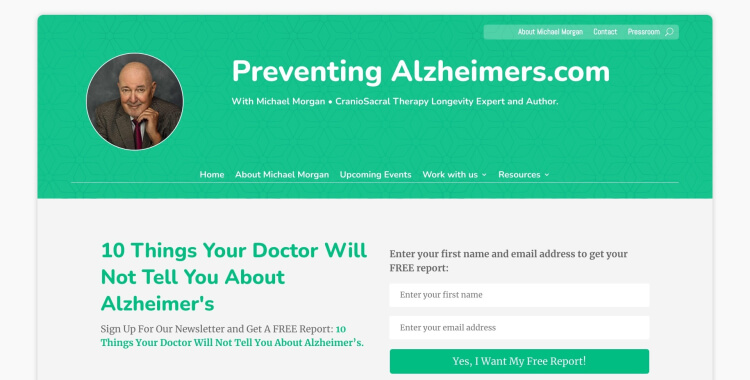
Right away, you’ll see a strong hook and a form to instantly gain a free report. A simple landing page will make it easy for people to know what they are signing up for.
Virtual Summits
I’m so passionate about virtual summits. They’re an excellent way to get new coaching clients and to share your knowledge and wisdom.
My summits have generated 5,000 to 25,000 new leads each time, and my first summit launch generated $50,000 dollars in revenue.
This is a great way to build your network, email list, and establish more credibility in your niche.
Virtual Workshops
If you are looking for a lot of the benefits of a virtual summit with less work, you may want to start with a virtual workshop.
I’ve had a lot of success with these, and so have my clients. Janine Bolon, the radio host I mentioned earlier, says this:
“From my first workshop, several people joined my group- and 1-on-1 coaching program. I intend to run one a month going forward, and I now use the workshops as my primary way of attracting clients!”
A virtual workshop on a topic you know well can demonstrate your expertise while also building your email list.
Plus, you can target emails specifically at people who have already gone through your workshop, advertising your one-on-one coaching services. That’s the power of email marketing.
Partnerships
Partnerships are another way to encourage growth between you and another business or organization. A good way to collaborate is by using this strategy, which allows you to pool your resources together to expand your audience.
Pick a company or charity offering complimentary services. For example, if you work in the fitness space, you might want to work with a gym clothing manufacturer. Working on email campaigns together can grow your list overnight.
Affiliate/JV Deals
A JV deal (or Joint Venture deal) is a business agreement between two parties. Similar to partnerships, this may allow you to work with a specific company to reach a goal.
Then, your affiliates will earn a commission for anyone who signs up for your email newsletter using their unique link. If you have the cash to spare, this is a great way to encourage your current client base to get sharing.
Referral Programs
A referral program works in a similar way to affiliate marketing. You can offer an incentive for your current followers to share your newsletter with others. For example, you can offer a percentage discount on a certain workshop or resource.
Email Shares/Forwarding
You can also encourage your subscribers to forward emails. This can be just a friendly sentence asking them to forward your email to someone who would find it helpful. This is a nice way to encourage organic growth for people within your niche.
How to Analyze and Optimize Email Performance
Learning to understand analytics is really important for optimal email growth.
Tracking Key Metrics
These are some of the most important email metrics to track:
- Open rate: This shows how many people have actually opened your emails
- Click-through rate: This shows how many people have clicked on a link or a CTA in your emails
- Conversion rate: This shows how many people have bought a product or signed up for a service using your emails
- Unsubscribe rate: This shows how many people have unsubscribed from your newsletter
- Bounce rate: The percentage of emails that couldn’t be delivered to an inbox
- List growth rate: The rate at which your email list is growing
- Overall ROI: Your total revenue minus any money you’ve spent
How to Analyze Data and Make Adjustments
Analyzing your emails is a great way to understand what connects with your audience.
I’d recommend starting with your open rate. This will allow you to see which subject lines are performing well enough to make people click. This information can inform your future subject lines but the data is not always reliable.
Then you can move on to click-through rates. Which emails are making people click through to your website? What connects with them the most? You can then consider making more content like this in the future.
As you send more emails, you’ll have more data to work with, allowing you to fine-tune your email marketing strategy.
Maintaining Compliance and Deliverability
This is really important, so don’t skip it. Compliance is key. Here are some terms you need to understand:
- DKIM (DomainKeys Identified Mail): An email authentication method using a digital signature, which lets the receiver know the message was sent from an authorized owner of a domain
- DMARC (Domain-based Message Authentication, Reporting, and Conformance): A standard that prevents spammers from using your domain to send emails
- CAN-SPAM (Controlling the Assault of Non-Solicited Pornography and Marketing Act of 2003): This is a law passed in 2003 in the US, which means you have the right to stop commercial messages from being sent to you
- GDPR (General Data Protection Regulation): This is an EU regulation on information privacy that protects individuals from unnecessary data collection
Your chosen email marketing platform should comply with all these things anyway, but it’s good to know about them.
You should also try to avoid spam filters, which can be a disaster for your open rates. You can avoid spam filters by:
- Only sending emails to your subscribers
- Avoid trigger words: HubSpot has a useful list of these.
- Go for double opt-in, which means your subscribers have to opt-in via email and then click a link
- Ask your subscribers to add you as a contact
Remember: permission-based marketing is key to growing your list. Buying lists may give you more followers, but they won’t be engaging with you and it will hurt your deliverability. It’s better to aim for slow and steady growth, rather than buying lists, which may not comply with laws and regulations.
Key Takeaways
There’s a lot to learn when it comes to email marketing, but I really believe it can be an incredible way for coaches to get new clients.
You can check out our Email Success Summit for more in-depth ideas and tips for your email marketing strategy.
And if you want more clients, watch our free training on how to get more coaching clients.